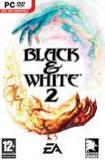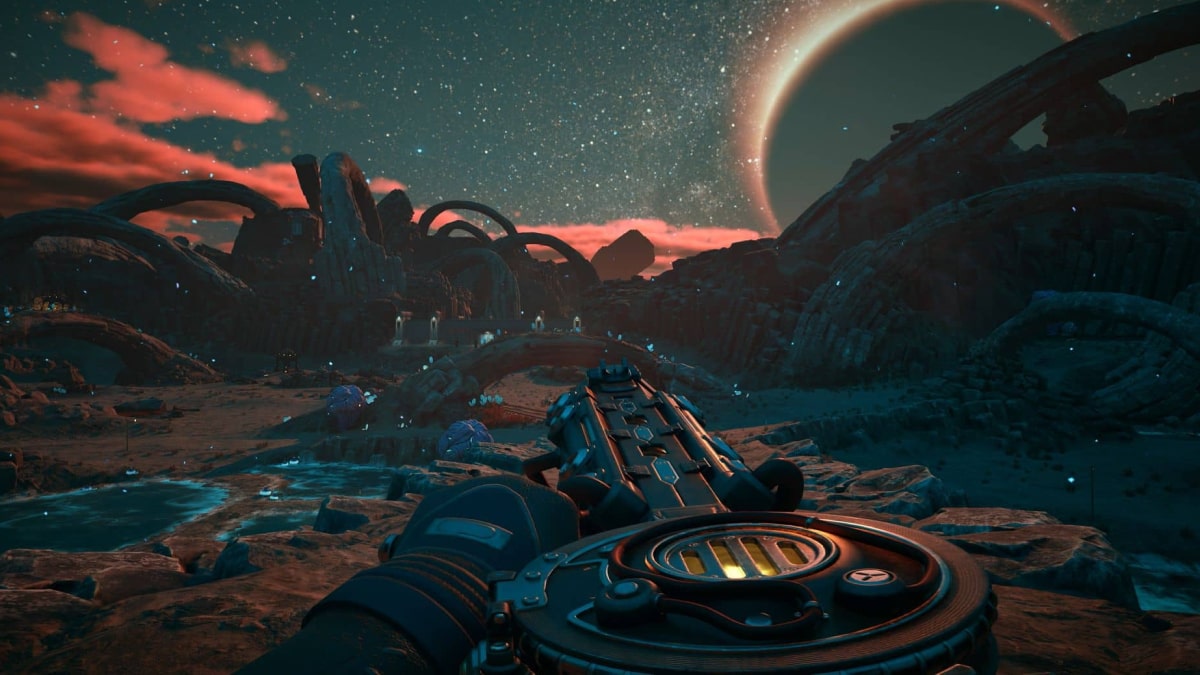You can trust VideoGamer. Our team of gaming experts spend hours testing and reviewing the latest games, to ensure you're reading the most comprehensive guide possible. Rest assured, all imagery and advice is unique and original. Check out how we test and review games here
“Play good, play bad, play god,” the tagline on the back of the game box implores you. Unfortunately, the overriding feeling I have from playing Black & White 2 isn’t one that I’ve been playing god. No, in fact, I feel a whole lot more like a middle manager, though I suppose “Play good, play bad, play David Brent.” didn’t quite have the same ring to it when they had the brainstorm session for the marketing strategy.
I hope you’ll forgive the rather sacrilegious tone to the start of the review, but the problem with Black & White 2 is that if the level of micro-management required by gods in the game is anything to go by, not to mention the relentless stupidity of your subjects, then it goes a long way towards explaining why God has kept his trap shut since carving out The Ten Commandments and giving them to Moses; being God, it would seem, isn’t nearly as much fun as you might think.
Initial impressions are mixed. The opening cinematic is essentially identical to the prequel. Someone at Lionhead obviously decided that the SFX movie from the first game of the god you play careering through the cosmos to the planet Eden was too good not be used again and was simply married to a barely revised voiceover. It’s not all bad: it’s undeniably a very good looking game. The scale and flexibility of the 3D engine is genuinely astonishing. To be able to zoom from an almost orbital view of the playing area right into being able to see the expressions on worshippers’ faces as they dance around the altar is a breathtaking feat of programming. You can even see the wind ruffling the long blades of grass and the wheat in the fields, and the textures and water effects are sumptuous.
Unfortunately, whilst the visuals impress, it’s all too easy to peel back this technological wallpaper covering the cracks (I say cracks, what I mean are more abyssal fissures) in the game design. Whilst the 3D engine has moved on leaps and bounds in the four years since the original, it quickly becomes apparent that the game design is living in the past. An unforgivable amount of time is spent on surely the most tedious in-game tutorial since… Black & White. I’m praying for one brave game designer somewhere, someday to design an in-game tutorial that just shows a screen with the following text: “READ THE BLOODY MANUAL!” I also resent being patronised in the most condescending manner possible that managing to hold down the right mouse button and move the mouse a few inches at the same time is “great work“. Whoooo! I RULE! I can use a mouse! This will be a piece of cake!
You’re asked to choose your creature straight away, but unlike in the prequel, there are no other creatures to be unlocked, so the choice you make between Ape, Cow, Lion and Wolf is an important one. No sooner have you chosen which creature you want to spend the game with, however, you’re bundled through another few tedious tutorials and denied the chance to interact with it; I’m not sure who thought that was a good idea. This opening island (of eight in total) displays almost staggering shonkiness in design. Not only are you unable to skip the opening camera tutorial after picking your creature, to make matters worse, you can’t skip the dialogue from the two halves of your conscience (yes, they’re back, and they’re just as annoying as in the original), even if you’ve heard it all three times before, and you’re just curious to see what the Cow is like for a couple of islands. Wait. It gets better! One of the game tweaks Black & White 2 features is that now you have to buy abilities and new structures using ‘Tribute’, which is given to you for completing Gold Scrolls and Silver Scrolls (story tasks and challenge tasks, respectively).
Even here, Lionhead have managed to stuff things up admirably. On the first tutorial island, once you’ve developed several stomach ulcers from grinding your teeth through the camera tutorial, you can either leave the island directly using a Gold Scroll, or continue with the tutorials to unlock the Silver Scrolls, meaning that if you don’t want to forfeit a whole load of useful Tribute, you have to plough through the hideous monotony of dragging a few rocks around a few inches of the screen, all the while being told how great you are, as if you had Attention Deficit Hyperactivity Disorder. Surely it wouldn’t have been such a great problem to set up a flag in the player profile to say “Yes, I have completed the tutorials, I don’t need to do them again” and simply have the Silver Scrolls unlocked for you to complete after you’ve picked your creature. It’s simply knuckleheaded design. The Silver Scroll challenges aren’t even that fun. The Waterfall quest aptly demonstrates how Lionhead haven’t fixed the cack-handed throwing mechanics from the first game, and the Nomad Valley quest likewise shows just how fiddly it is to pick up villagers if you don’t have the camera set just so. As for the Rock Garden challenge, that’s so insultingly easy that it’s barely worth sitting through the (unskippable) cutscene telling you what to do. No wonder I dropped the rock on the villager’s house, and then threw him into the sea. This, however, exposes yet another problem in the game design: You don’t get Tribute for concluding challenges evilly. So you have to be good if you want to gain enough Tribute to buy the really powerful spells later in the game; So much for having choice, eh?
Once you leave the first island, the game then pulls exactly the same trick as the first game did. You’re whizzed off to see your homeland, only to see it destroyed by raging Aztecs. So you get to plonk a couple of people through portals, roll a few flaming hay bails over Aztec platoons and use those whizzo camera madskillz you developed on the tutorial island. Oh wait, no you don’t. All the action takes place on static screens where you don’t need to (and indeed, can’t) move the camera. Another ulcer and several capped teeth later, you get to the second island, where… you’re given more tutorials to do! And it deliberately prevents you from using abilities (such as creating Disciples) until you’ve completed its requisite tutorial! Give me a minute; I’m just off to the chemist for some Rennies.
There; that should keep me from vomiting blood all over my keyboard for another couple of hundred words. To be fair, these particular tutorials on the second island actually allow you to finally do something useful in the game, and can thereby be tolerated (grudgingly), so once you finally get to grips with managing your settlement, you can then (finally) play with your creature. Creatures now have Roles that they can take: Builder, Gatherer, Soldier and Entertainer. Alternatively or you can leave them to their own devices in the Free Will Role. The Roles essentially make your creature a Disciple, and you can use the leash to fix your creature to a set position if you want him to work in a particular area. These Roles make your creature a lot more controllable, but I’m still not sure if that’s a good thing. One of the real beauties of the original was that to get your creature to do useful things, you really had to invest time and effort to make it learn spells, not to eat villagers and not throw poo into the storehouse. Here, thought bubbles can tell you exactly what the creature is thinking, and a quick stroke or slap will ensure you never have to worry about it trying to feed itself on ore rocks and subsequently spewing its guts out over its pen, or having your citizens subjected to Crushing Death By Turd. In their efforts to make the creatures more accessible (and, dare I say, useful) Lionhead have only succeeded in marginalising their attraction. No longer do you have to spend time with it trying to teach it spells. No, you just buy them from the Tribute menu. Instead of having to make it watch you gather grain from the fields and put it in the storehouse, you just click a button, attach a leash, and you’ve got your own little robot minion doing your bidding. Okay, they’re cute as hell little robot minions, but the Roles effectively negate any need you might feel to spend time with them, because the Roles override what they may have learned (or what you’ve taught them to do).
You’re probably going to be far too busy town building to worry about your creature anyway. This is where I get back to my opening paragraphs: namely the feeling that you’re more a manager than god. Firstly, your citizens are idiots. If you don’t tell them what to do, they’ll quite happily starve to death (“Need food!”) rather than wander over to the vast tracts of agrarian land that you’ve provided them with and get some for themselves. They’ll also plaintively wail “Need sleep!” in the middle of the night, and promptly go wandering around the local meadow (or down the road to the nearest tavern) instead of going to bed. I’m sorry? What do you want me to do about that? Put you to bed personally? Or just throw you off the top of a mountain? Your subjects also have absolutely no initiative of their own for expanding their town. You have to do everything for them. Even with a veritable army of Disciple Builders, once you put down the foundations of buildings, you’re usually much better off dropping wood and ore directly onto them, because if you leave it to the Builders it’ll take hours and all the biscuits and tea bags will disappear from your cupboard. True story.
Doing all the building yourself does have its advantages, of course. You can build some spectacular cities, and canny placement of roads will allow you to maximise the use of available ground and boost the Impressiveness of your town. Certain structures, such as Universities, Temples, and the like, will make your city appealing to the occupants of other towns on the island. If you’re able to make your town sufficiently impressive, you can even take over the enemy city without a fireball being thrown in anger. “Where’s the fun in that?” I hear you cry. Victory through urban sprawl isn’t quite my idea of fun, and I LIKE micro-management. Achieving the island victory condition this way literally takes hours of meticulous planning and building, and makes you feel that you’re playing a fantasy-styled Sim City. Ironically, this is actually more fun than achieving victory the other way – through violence.
You can now build armies, replete with swordsmen, siege engines and archers, plus (of course) your creature in Soldier mode. Combat is more Rome, Paper, Scissors than Rome: Total War. There’s no real scope for tactics at all. Just chuck men at each other, bung your creature into the mix for good measure and stand by with a couple of Heal miracles whilst the two sides grind it out. You can achieve the victory conditions a heck of a lot quicker this way, but otherwise it’s a pretty empty experience. It’s even amusing to use an army to take over a deserted town, and have the nonexistent population tell you that they “Need Wood!” or some other resource that a population of zero could inexplicably want.
In spite of all this, incredibly, I do quite like it. Perhaps I’ve just got a soft spot for defective strategy games (A game of Star Wars: Supremacy, anyone?). Like its predecessor, the game’s vision exceeds its execution, but it’s not without charm. Virtually all the flaws from Black & White make a reappearance (with a few new ones, besides) and really should have been addressed. The unskippable conscience dialogues, awful tutorial, cursor imprecision, some dreadfully uninspired Silver Scroll challenges (which made me somewhat nostalgic for “Eidle, eidle, eeee!” boat quest from the original) and a script that’s awful in places all drag the final score down. If they’re not fixed in the inevitable sequel/expansion pack, I’m going to personally throw a fireball in the direction of Guildford and to hell with the collateral damage. Technically, however, it’s magnificent. You’ll struggle to find a better looking strategy game and the interface is much improved, but the game doesn’t have the “Wow!” factor of the original – you simply can’t overlook the gaping holes in the design this time around. How it manages to be entertaining at all is beyond me, but it is. Well, they do say God moves in mysterious ways…

/https://oimg.videogamer.com/images/60b0/black__white_2_52.jpg)
/https://oimg.videogamer.com/images/981b/black__white_2_53.jpg)
/https://oimg.videogamer.com/images/c3c4/black__white_2_57.jpg)






